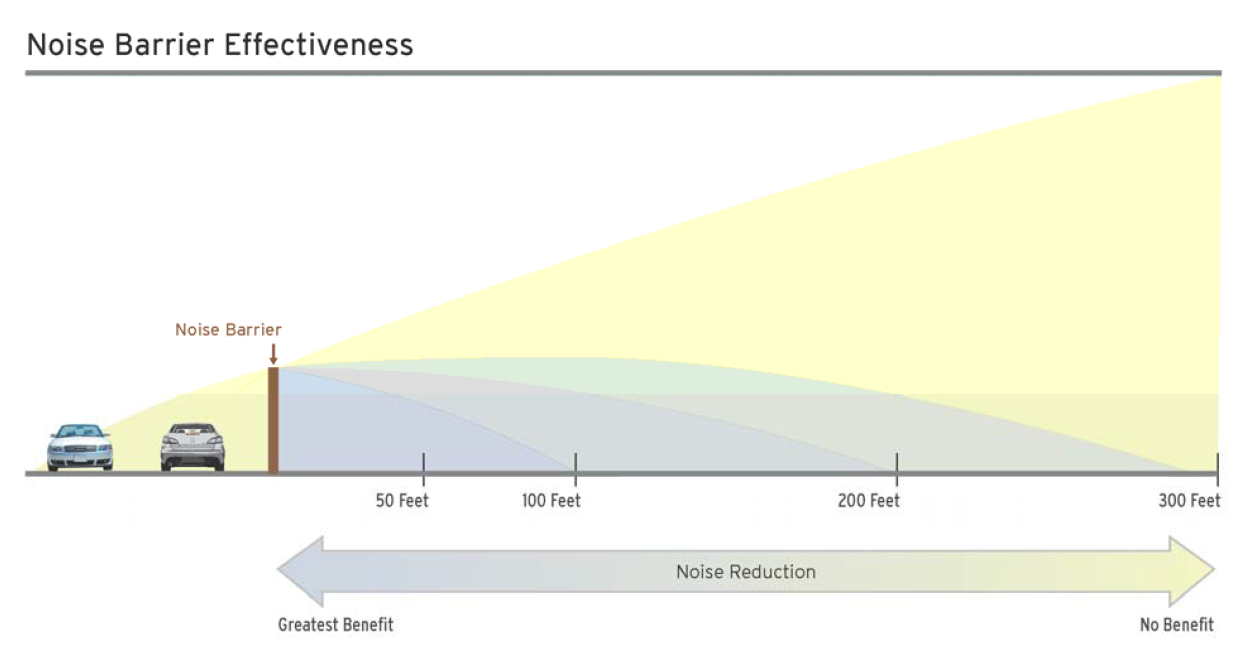Engineers and acousticians have known for years that the sound barriers bracketing America’s urban and suburban highways are only marginally useful, and that a variety of better technologies could be developed.
The problem: Nobody has an incentive to get them on the road.
“Walls are not a very effective solution,” said Robert Bernhard, vice president for research at the University of Notre Dame and an expert on noise control. Because the federal government pays for noise walls — and only noise walls — as part of highway expansion projects, he said, there is little incentive for researchers to keep testing and perfecting the alternatives.
Sound moves in not-so-mysterious ways, meaning that typical sound barriers have only limited effectiveness.
Visual: Wisconsin DOT
[…]
Even with the sound reduction, however, roadside residents are unlikely to hear crickets chirping. A dishwasher running in the next room is 50 dB, as are the ambient sounds of a laid-back city. The noise criteria aim to allow people to talk over their backyard picnic table, or shout at someone several feet away. “It’s not a situation where meeting the standard makes for a great backyard environment,” Bernhard said.
Of course, some of our ability to process sound is psychological: If people can see the tops of trucks over the wall they say it’s noisier, something people in the field call “psycho-coustics,” explained Bruce Rymer, a senior engineer at the California Department of Transportation. Just by ensuring a wall breaks that line of sight, “we achieve a reduction of 5 decibels,” said Mariano Berrios, environmental programs coordinator at FDOT.
But because noise travels in waves, not straight lines, sounds can and do go over the walls. This is why even with barriers standing 16 feet, homes several blocks away can hear the highway. Part of the sound wave is absorbed, part is reflected away from the wall, and part is transmitted through, Berrios explained. “Most of it goes above the barrier and gets diffracted, and gets to the receiver,” — that is, to a resident’s ears — he said.
This is especially problematic during certain weather conditions. When the consulting firm Bowlby & Associates, in Franklin, Tennessee, measured sounds around a highway in a yet-to-be-published study, they found that residents hundreds of feet from the highway could hear sounds some 5 decibels louder if the wind was blowing towards them, said Darlene D. Reiter, the firm’s president.
Weather, however, isn’t taken into account by the regulations. The noise model “assumes neutral conditions — no wind and no temperature effects — when in reality that happens only occasionally,” Reiter said. In the early morning, if the ground is cool but the air warms up, for instance, sound that would normally be pushed up is refracted downward, causing homes some 500 or 1,000 feet from the road to hear it loudly.
Source: On Highway Noise Barriers, the Science Is Mixed. Are There Alternatives?

Robin Edgar
Organisational Structures | Technology and Science | Military, IT and Lifestyle consultancy | Social, Broadcast & Cross Media | Flying aircraft

